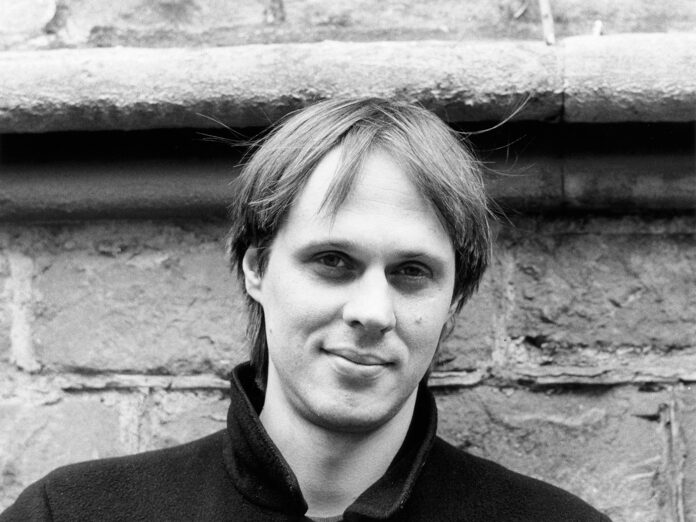By the time Tom Verlaine stepped into the studio to record his first instrumental album, Warm And Cool [1992], he’d pretty much burned out on the endless cycle of record-release-tour dynamics that goes with life on a major label. Having played the game long enough, Verlaine had taken stock, and was keen to redraw the parameters of both his artistic and his everyday life. He’d long entertained a desire to record an instrumental collection, and there did seem to be something particularly appropriate about one of the most idiosyncratic and individual of guitar players going the instrumental route. For anyone who’d listened to the ecstatic flight of Verlaine’s bird-like guitar over the preceding two decades, Warm And Cool was no surprise; it was simply good to hear Verlaine in this new setting, one that so neatly suited his aesthetic.
By the time Tom Verlaine stepped into the studio to record his first instrumental album, Warm And Cool [1992], he’d pretty much burned out on the endless cycle of record-release-tour dynamics that goes with life on a major label. Having played the game long enough, Verlaine had taken stock, and was keen to redraw the parameters of both his artistic and his everyday life. He’d long entertained a desire to record an instrumental collection, and there did seem to be something particularly appropriate about one of the most idiosyncratic and individual of guitar players going the instrumental route. For anyone who’d listened to the ecstatic flight of Verlaine’s bird-like guitar over the preceding two decades, Warm And Cool was no surprise; it was simply good to hear Verlaine in this new setting, one that so neatly suited his aesthetic.
BRUCE SPRINGSTEEN IS ON THE COVER OF THE NEW UNCUT – ORDER YOUR COPY HERE
There were other things going on, of course. Warm And Cool was released in the same year as Television’s third, ‘comeback’ album. This self-titled set was received curiously; like everything Verlaine had done to this point, it suffered from living under the shadow of the band’s debut album, 1977’s Marquee Moon, by any measure an extraordinary rock album, and one that was already considered an iconic statement by critical and cultural consensus alike. Listening back, that third Television album works differently to what came before – as you’d expect, given the 14-year gap between it and its predecessor, Adventure – but it’s an album that doesn’t compromise, that doesn’t stint on great songs and playing, and that stands proud alongside Marquee Moon. It’s neither better nor worse, just different.
Television gave listeners their fill of Verlaine in songwriting mode, and in that respect, it also felt an extension of his run of superlative solo albums through the ’80s. Warm And Cool was its other side. It also set Verlaine on a new path, one where his music could nestle tidily within numerous different contexts. While the most obvious line you can sketch from Warm And Cool is to its instrumental 2006 successor, Around, it also points toward Verlaine’s work in soundtracking, and his improvisatory guitar duos with the likes of Jimmy Rip, including their performances playing alongside screenings of early 20th-century experimental film. Warm And Cool opened doors to experiences that Verlaine would chase for decades to come, all while letting the Television machine play out in slow motion – the odd tour here and there; some inconclusive recording sessions for a fabled, and never released, fourth album.
For anyone who thinks Warm And Cool would be an ambient drift, a collection of meanders and longueurs, though, listening back, it’s surprising how spiky it is at times. Recorded across two sessions, taking two days altogether to track – though mostly done on one night – Warm And Cool is a masterpiece in threading, where Verlaine seems to be grabbing hold of a simple melody, or cluster of chords and notes, throwing them to his fellow musicians to see what they make of them, and then capturing the wild, sometimes flustered ride of the moment. It helps, of course, that those fellow musicians are excellent players – on almost the whole album, it’s Patrick Derivaz on bass and Television’s Billy Ficca on drums. A song like “Ore” sparks with incandescence, Verlaine’s guitar shard-like as Ficca accents Verlaine’s playing with rumbling, clattering drums, Derivaz leaving notes hanging.
It’s also a welcome reminder that Verlaine wasn’t influenced by guitarists so much as he was free jazz saxophonists – John Coltrane, Albert Ayler and suchlike – and it’s that logic he pursues across much of Warm And Cool (the only guitarist that really seems a considered influence on Verlaine might be Mike Bloomfield). Sometimes things get subdued – the following “Depot (1958)”, or the spiralling, flinty “Saucer Crash” – and occasionally Verlaine’s guitar threads notes, like hints, across analogue silence, laying a trail of blinking lights through a darkened studio. The gently swinging “Harley Quinn” sits outside the general mood of Warm And Cool – satellited in from another session, it features Fred Smith of Television on bass, and Jay Dee Daugherty from Patti Smith’s band on drums.
It took Verlaine another 12 years to release Warm And Cool’s instrumental sequel, Around; on the same day in 2006, he also released Songs And Other Things, an album predominantly of vocal songs. Around seems lighter in the air than Warm And Cool, made up of a string of fleeting impressions, slippery statements for guitar. It’s rare for Verlaine’s music to sound like anyone else’s, but moments on Around recall the dustbowl laments of Neil Young’s Dead Man soundtrack, or the more stripped-back moments on Roy Montgomery’s albums – a similar psychic space is being explored here, perhaps.
Around was recorded across two days in December 1996, but Verlaine sat on the recordings for a decade. Ficca and Derivaz are in tow, again, though they are less present than on Warm And Cool – with Around, Verlaine fully embraced a less-is-more aesthetic, and the guitar playing here often shivers in its intimacy, its nakedness. But there’s also playfulness, as on the slow-mo highlife of “Meteor Beach”, where slide guitar and chiming riffs play against string scrape, and one of the most ridiculous muffled wah tones you’ll hear (it sounds like Verlaine was aiming for muted trumpet on the guitar).
Ficca and Derivaz also appear on Songs And Other Things, the album that is perhaps the real revelation of this reissue series. This was Verlaine’s first collection of songs since 1990’s underrated The Wonder; what’s particularly impressive about Songs And Other Things, though, is how convincing it sounds, how Verlaine seems to have reached a new level with his songwriting. The lyrics oscillate between suggestive poetry, evasive asides, chuckling character profiles and excerpts from unfilmed crime series – there’s a gaggle of different Verlaines in here, and they’re all wry and smart.
Most importantly, though, the songs are ecstatic things: from the simple, one-chord mantra of “The Day On You”, to the bleary-eyed, mystical waltz of “Blue Light”, and the elevated, rapturous bliss-out of “The Earth Is In The Sky”, the latter a virtual masterclass in Verlaine guitar playing too – spindly filigrees carved into the finely rendered sides of a glorious chord change that’s heaven-sent – Verlaine’s songs here are never less than lovely, and often mesmerising. The guitar across the album, too, feels particularly inspired, and the intimacy in the playing is so singular you feel you can hear Verlaine’s hands, fingers, nails, sinew, the blood pumping through veins: a masterclass in touch, a haptic listening experience.
In her liner notes to Sonic Youth’s 1993 reissue of Daydream Nation, artist and writer Jutta Koether quotes Verlaine, her life partner: “There are moments, rare on any record, where the wild searchings of the guitarists collide in what might be described as a ‘radiance’. It’s like being caught in the rapids, bumping off rocks, then going over the waterfall – and really liking it.” It’s a beautiful quote that sums up much of what made Verlaine’s guitar playing, both in interplay with Richard Lloyd and Jimmy Rip, and solo, so glorious and unpredictable. On these final three albums, Verlaine captured that radiance to its fullest, and unassumingly reached heightened states through the seemingly simple interface of one man and his guitar. It’s hallucinatory in effect – and revelatory.



